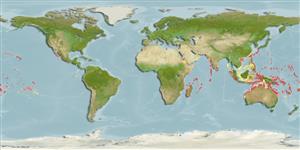Common names from other countries
>
Gobiiformes (Gobies) >
Microdesmidae (Wormfishes) > Ptereleotrinae
Etymology: Ptereleotris: Greek, pteron = wing, fin + The name of a Nile fish, eleotris (Ref. 45335).
More on author: Fowler.
Environment: milieu / climate zone / depth range / distribution range
Écologie
marin récifal; profondeur 2 - 31 m (Ref. 1602), usually 2 - 4 m (Ref. 1602). Tropical; 22°C - 28°C (Ref. 27115); 30°N - 30°S
Indo-Pacific: Red Sea and islands in the western Indin Ocean (Ref. 528) to the Line and Marquesas Islands, north to the Ryukyu Islands, south to the southern Great Barrier Reef; Mariana and Marshall Islands in Micronesia.
Taille / Poids / Âge
Maturity: Lm ? range ? - ? cm
Max length : 12.0 cm SL mâle / non sexé; (Ref. 48637)
Épines dorsales (Total) : 7; Rayons mous dorsaux (Total) : 27 - 29; Épines anales: 1; Rayons mous anaux: 25 - 28; Vertèbres: 26. Yellowish to greenish gray in color; lower half of eye to ventral of chin nearly enclosed by a broad blue-edged dark red to purple area; opercle with 2 diagonal bright blue bands; pectoral fin base with an orange-red bar broadly bordered with bright blue. Chin barbel followed by a median longitudinal fold. Fins yellowish; 2nd dorsal a median longitudinal row of blue spots.
This schooling species inhabits exposed seaward reefs in relatively shallow water, over hard bottoms. Usually many individuals occupy the same refuge. Found to be subjected to strong currents, where in small to large aggregations (Ref. 48637). Feeds on zooplanktons (Ref. 89972).
Life cycle and mating behavior
Maturities | Reproduction | Spawnings | Egg(s) | Fecundities | Larves
Randall, J.E. and D.F. Hoese, 1985. Revision of the Indo-Pacific dartfishes, genus Ptereleotris (Perciformes: Gobioidei). Indo-Pac. Fish. (7):36 p. (Ref. 528)
Statut dans la liste rouge de l'IUCN (Ref. 130435)
CITES (Ref. 128078)
Not Evaluated
Menace pour l'homme
Harmless
Utilisations par l'homme
Pêcheries: commercial; Aquarium: Commercial
Outils
Articles particuliers
Télécharger en XML
Sources Internet
Estimates based on models
Preferred temperature (Ref.
115969): 25 - 29.3, mean 28.2 (based on 2283 cells).
Phylogenetic diversity index (Ref.
82804): PD
50 = 0.5000 [Uniqueness, from 0.5 = low to 2.0 = high].
Bayesian length-weight: a=0.00389 (0.00180 - 0.00842), b=3.12 (2.94 - 3.30), in cm Total Length, based on all LWR estimates for this body shape (Ref.
93245).
Niveau trophique (Ref.
69278): 3.4 ±0.45 se; based on food items.
Fishing Vulnerability (Ref.
59153): Low vulnerability (10 of 100).
